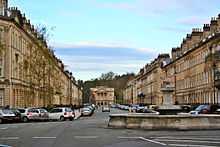Great Pulteney Street

Great Pulteney Street is a grand thoroughfare that connects Bathwick on the east of the River Avon with the City of Bath, England via the Robert Adam designed Pulteney Bridge. Viewed from the city side of the bridge the road leads directly to the Holburne Museum of Art that was originally the Sydney Hotel where tea rooms, card rooms a concert room and a ballroom were installed for the amusement of Bath's many visitors.
History
Commissioned by Sir William Pulteney, it was designed by the architect Thomas Baldwin and completed in 1789. The council wanted to expand the boundaries of the City, and Sir William's estate was conveniently situated just over the other side of the River Avon.
At over 1,000 feet (300 m) long and 100 feet (30 m) wide, the road itself is the widest and grandest in Bath. The architect only constructed the façade though – developers acquired plots and built the actual structures behind. This means that, although obviously similar, many of the properties have different internal features, and some large stretches were used to build hotels.
It was intended that, along with the access provided by Pulteney Bridge, the eastern side of the Avon would be popular with speculators and developers. This appears not to have been the case – no further developments were made on this scale, and one of the side streets off Great Pulteney Street, Sunderland Street, is the shortest street in town, with only one address. After 1789 the financial climate did not encourage further building, the Panic of 1797 (Deflation 1793 – 1800) was followed by the Depression of 1807. Bath was also affected by a serious flood in 1809[1] which would have inundated many of the basements in Great Pulteney Street and the surrounding fields.
Famous former residents of the street have included the novelist Jane Austen and the anti-slavery campaigner William Wilberforce. Numbers 1 to 7 were a single government office, now designated as a Grade I listed building.[2] Numbers 41A and 42 to 77 have also been Grade I listed.[3]
The fountain (Great Pulteney Street/Laura Place) was not part of the original plan. After completion of the main street in 1877 local residents petitioned and successfully raised significant funds to build a grand column (rather like Nelson's Column in London). However as construction of the column started, the residents realised that the addition would tower over the area (it would be 50% taller than the houses), and so they then petitioned for it to be cancelled. After some negotiations, the column was pulled down and the much smaller fountain added instead.
Drawings of all the building plans (including many proposals that were never built) can be viewed in the Victoria Art Gallery situated on the corner of Pulteney Bridge and Grand Parade.
Gallery
-
8-20 Great Pulteney Street
-
40 Great Pulteney Street
-
41A Great Pulteney Street
-
42-52 Great Pulteney Street
-
66-77 Great Pulteney Street
References
- ↑ Structures & construction in historic building conservation By Michael Forsyth, 2007.
- ↑ "Nos 1 to 7 (consec) 12.6.50. Nos 8 to 10 (consec), 10A & 12.6.50. ll to 20 (consec) 14.7.55. No 21 12.6.50 Nos 22 to 3O (consec) Nos 31 to 34 (consec) 12.6.50. Nos 35 & 36 14.7.55. No 37 12.6.50. Nos 38 to 40 (consec) Great Pulteney Street". Images of England. English Heritage. Retrieved 2009-07-19.
- ↑ "No 41A Nos 42 to 77 Great Pulteney Street". Images of England. English Heritage. Retrieved 2009-07-19.
Coordinates: 51°23′04″N 2°15′15″W / 51.3844°N 2.2543°W




